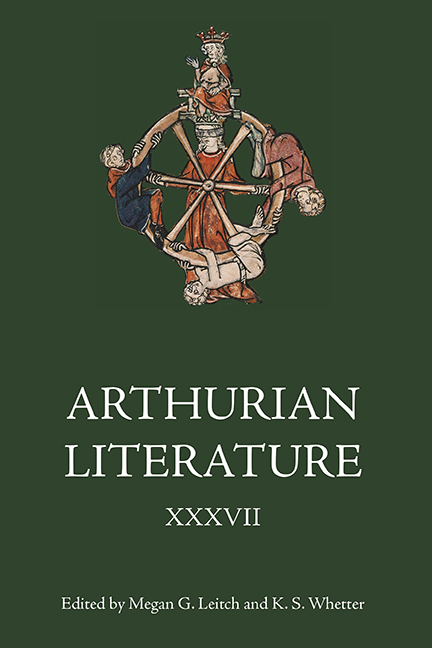Book contents
- Frontmatter
- Contents
- List of Charts and Tables
- Professor Fiona Tolhurst (1968–2021)
- General Editors’ Preface
- List of Contributors
- List of Abbreviations
- Introduction: The Tournament at Mapplemalleoré: Malory at 550
- 1 Malory and the Stock Phrase
- 2 The Artistry of Malory’s Mercantile Metaphors: Goods, Generosity, and the Source of ‘The Tale of Sir Gareth’
- 3 ‘A grete bourder and a passynge good knyght’: Sir Dinadan: ‘Gareth with a Twist’
- 4 Moonlight in the Nocturnal Typology of Malory’s Morte Darthur
- 5 ‘That shall nat ye know for me as at thys tyme’: Cognitive Narratology and Filling Malory’s Gaps
- 6 ‘On a tyme’: Action and Temporality in Malory’s ‘Sankgreal’
- 7 Hospitality in Malory
- 8 The Haunting of the Orkneys and Malory’s Arthurian Project
- 9 ‘I love nat to be constreyned to love’: Launcelot and Coerced Sex
- 10 Eradicating Victorian Backreading: Re-reading Malory’s Gwenyvere through Gaynour and Isode
- contents of previous volumes
5 - ‘That shall nat ye know for me as at thys tyme’: Cognitive Narratology and Filling Malory’s Gaps
Published online by Cambridge University Press: 15 September 2022
- Frontmatter
- Contents
- List of Charts and Tables
- Professor Fiona Tolhurst (1968–2021)
- General Editors’ Preface
- List of Contributors
- List of Abbreviations
- Introduction: The Tournament at Mapplemalleoré: Malory at 550
- 1 Malory and the Stock Phrase
- 2 The Artistry of Malory’s Mercantile Metaphors: Goods, Generosity, and the Source of ‘The Tale of Sir Gareth’
- 3 ‘A grete bourder and a passynge good knyght’: Sir Dinadan: ‘Gareth with a Twist’
- 4 Moonlight in the Nocturnal Typology of Malory’s Morte Darthur
- 5 ‘That shall nat ye know for me as at thys tyme’: Cognitive Narratology and Filling Malory’s Gaps
- 6 ‘On a tyme’: Action and Temporality in Malory’s ‘Sankgreal’
- 7 Hospitality in Malory
- 8 The Haunting of the Orkneys and Malory’s Arthurian Project
- 9 ‘I love nat to be constreyned to love’: Launcelot and Coerced Sex
- 10 Eradicating Victorian Backreading: Re-reading Malory’s Gwenyvere through Gaynour and Isode
- contents of previous volumes
Summary
Near the beginning of the ‘Tale of Sir Gareth’, on Whit Sunday, an unnamed damsel arrives at Arthur's court, helpfully fulfilling Arthur's desire to hear some strange adventures before he dines. But she unhelpfully withholds much of the relevant information:
‘Sir,’ she seyde, ‘I have a lady of grete worshyp to my sustir, and she is beseged with a tirraunte, that she may nat oute of hir castell. And bycause here ar called the noblyst knyghtes of the worlde, I com to you for succoure.’
‘What is youre lady called, and where dwellyth she? And who is he and what is his name that hath beseged her?’
‘Sir kynge,’ she seyde, ‘as for my ladyes name, that shall nat ye know for me as at thys tyme, but I lette you wete she is a lady off grete worshyp and of grete londys; and as for that tyrraunte that besegyth her and destroyeth hir londys, he is kallyd the Rede Knyght of the Rede Laundys.’
‘I know hym nat,’ seyde the kyng.
‘Sir,’ seyde Sir Gawayne, ‘I know hym well, for he is one of the perelest knyghtes of the worlde. Men sey that he hath seven mennys strengthe, and from hym I ascapyd onys full harde with my lyff.’
‘Fayre damesell,’ seyde the kynge, ‘there bene knyghtes here that wolde do hir power for to rescowe your lady, but bycause ye woll not telle hir name nother where she dwellyth, therfore none of my knyghtes that here be nowe shall go with you be my wylle.’
‘Than muste I seke forther,’ seyde the damesell.
I have chosen this example because Malory directs our attention to what we do not know. We readers, like Arthur's court, do not know the lady's name or location; neither do we know why the damsel is choosing to withhold this information, though Arthur tells her that her refusal to say more is preventing her from getting the help she seeks.
But this is just one example of the kind of gap that is everywhere in the Morte: explanations are withheld, motivations are unclear, actions and words are inscrutable, and the causes of events mysterious. Jill Mann has observed that this obfuscation is deliberate: Malory often removes explanations and clarifications that are there in his sources.
- Type
- Chapter
- Information
- Arthurian Literature XXXVIIMalory at 550: Old and New, pp. 89 - 108Publisher: Boydell & BrewerPrint publication year: 2022



